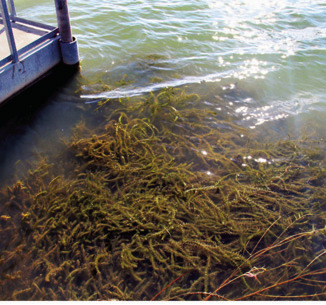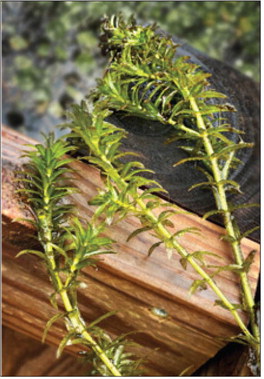Invasive hydrilla, an aquatic weed, has been confirmed for the first time in Robert S. Kerr Reservoir in far eastern Oklahoma, according to the Oklahoma Department of Wildlife Conservation. This aquatic nuisance species (ANS) was discovered by ODWC fisheries biologists during recent sampling efforts.
Hydrilla is considered one of the worst aquatic weeds in the United States.
'Once hydrilla has made its way into a body of water, it will very likely persist as it is incredibly hardy and will further spread the more it is fragmented, said Fisheries Biologist Elaine Gainer, aquatic nuisance species coordinator for the wildlife department.
Hydrilla, native to parts of Asia, Africa, and Australia, was first introduced to the U.S. in the 1950s as a live plant used in the aquarium trade. Hydrilla was first found in Oklahoma in 2006. Now, hydrilla has been found in nearly 40 states.
It is a submerged, rooted perennial with long stems (up to 30 feet) that branch at the surface and form dense mats. Small white flowers grow above the waterline on stalks. The stems are covered in small, pointed, often serrated (“sawtoothed edge”) leaves, which are bright green and measure 5/8 of an inch long.
Hydrilla is named after Hydra, the nine‐headed serpent of Greek mythology, because it can grow an entirely new plant from a tiny stem fragment.
ODWC’s Aquatic Nuisance Species program has confirmed invasive hydrilla in Lake Murray, Lake of the Arbuckles, Sooner Lake, Lake Nanih Waiya, Ardmore City Lake, Scott King Lake, and the Lower Mountain Fork River.
In just a few years from first arriving in a waterbody, ANS can significantly infest the ecosystem. Preventative actions taken by boaters and other people using infested waters is vital to slow or stop the spread of invasive nonnative species like hydrilla. Using the “Clean, Drain, Dry” procedure is highly encouraged.
To fight ANS, please remember to drain bilge water, live wells, bait buckets, and boat motors; inspect boats and trailers when leaving the water; scrape off any mussels or aquatic vegetation found when on dry land; then wash and dry off the boat, trailer and accessories. Also, boats allowed to dry for at least a week after contacting infested water are considered safe to take to a different waterbody. For more information on “Clean, Drain, Dry,” go to StopAquaticHitchhikers. org or wildlifedepartment. com/fishing/regs/aquatic- nuisance-species-ans.
Gainer said invasive species of any kind — plant or animal — should never be returned to the water, and any sightings suspecting ANS should be reported to ODWC by submitting a form online at wildlifedepartment.com/ wildlife/report-wildlife or by calling 918-200-4815. Anyone reporting a suspected invasive species should take photos to help experts with species identifi cation.
To learn more about various invasive species affecting Oklahoma, go to wildlifedepartment. com/wildlife/fieldguide/ invasive.

Hydrilla in Lake Murray

Hydrilla closeup


